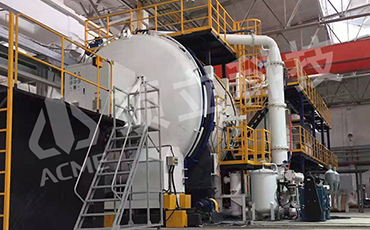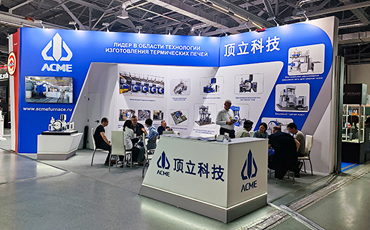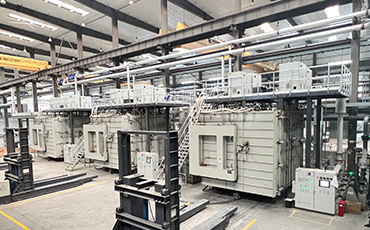Core Process of Vacuum Graphitization Furnaces
A vacuum graphitization furnace is an industrial apparatus designed for high-temperature processing of carbon materials. Its core process involves subjecting carbon materials (such as carbon fibers, anode materials, etc.) to extreme temperatures (2000–3000°C) in a vacuum or inert gas environment, enabling their transformation into a highly ordered graphite crystal structure through graphitization. Below is a detailed analysis of the fundamental process:
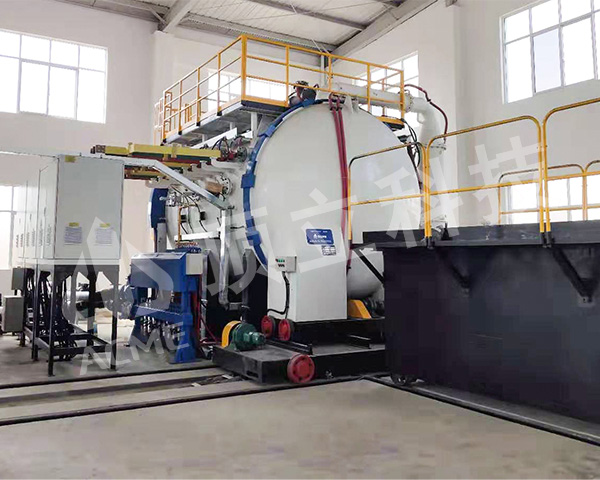
1. Temperature Control and Gradient Heating
1.1 High-Temperature Range: Graphitization requires temperatures above 2000°C (up to 3000°C), achieved through resistance heating (graphite heating elements) or induction heating.
1.2 Gradient Heating: A staged heating process prevents material cracking due to thermal stress, for example:
Low-Temperature Phase (<1000°C): Removal of volatiles (e.g., moisture, residual organic compounds).
Medium-Temperature Phase (1000–2000°C): Preliminary ordering of carbon structures.
High-Temperature Phase (>2000°C): Growth of graphite crystals, forming highly crystalline structures.
2. Vacuum Environment Control
2.1 Vacuum Level: Typically maintained at 10⁻³–10⁻² Pa, with critical functions including:
Oxidation Suppression: Prevents reaction of carbon materials with oxygen at high temperatures to form CO/CO₂.
Impurity Removal: Evacuates gases, ash, and low-boiling-point impurities from the materials.
Reduction of Thermal Conduction Loss: Minimizes heat convection by gas molecules, improving heating efficiency.
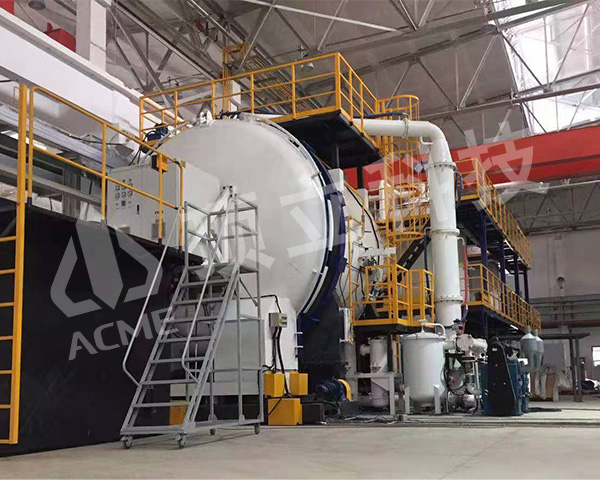
3. Atmosphere Control
3.1 Inert Gas Assistance: Introducing argon (Ar) or nitrogen (N₂) during specific process stages to:
Regulate furnace pressure and suppress material volatilization (e.g., lithium loss in lithium-ion battery anodes).
Assist heat transfer and improve temperature uniformity (particularly during cooling phases).
2. Vacuum Environment Control
2.1 Vacuum Level: Typically maintained at 10⁻³–10⁻² Pa, with critical functions including:
Oxidation Suppression: Prevents reaction of carbon materials with oxygen at high temperatures to form CO/CO₂.
Impurity Removal: Evacuates gases, ash, and low-boiling-point impurities from the materials.
Reduction of Thermal Conduction Loss: Minimizes heat convection by gas molecules, improving heating efficiency.
3. Atmosphere Control
3.1 Inert Gas Assistance: Introducing argon (Ar) or nitrogen (N₂) during specific process stages to:
Regulate furnace pressure and suppress material volatilization (e.g., lithium loss in lithium-ion battery anodes).
Assist heat transfer and improve temperature uniformity (particularly during cooling phases).
5. Physicochemical Changes During Graphitization
5.1 Structural Transformation: Amorphous carbon → Turbostratic structure → Three-dimensionally ordered graphite crystals.
5.2 Performance Enhancement:
Electrical Conductivity: Perfection of sp² hybridized structures within the graphite lattice.
Thermal Conductivity: Reduction of crystal defects and enhanced phonon transport.
Mechanical Strength: Optimized grain boundary bonding (e.g., increased tensile strength in carbon fibers).
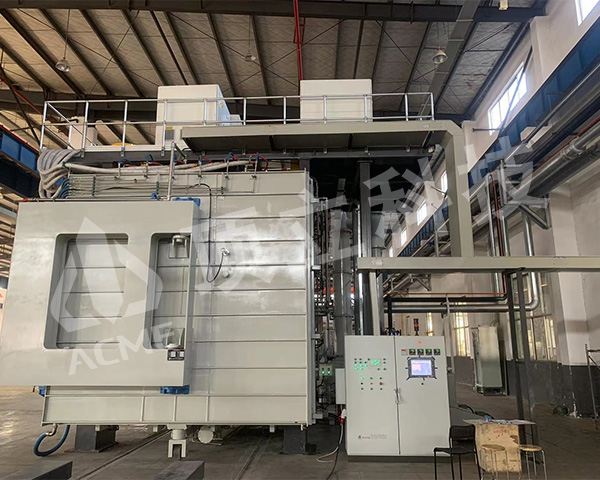
6. Precise Control of Process Parameters
Heating Rate: Influences grain size; excessively rapid heating induces structural defects, while overly slow heating reduces efficiency.
Soaking Time: Determines the degree of graphitization (prolonged soaking improves crystallinity but increases energy consumption).
Cooling Rate: Slow cooling (<5°C/min) minimizes thermal stress and prevents material cracking.
7. Quality Monitoring and Testing
Online Monitoring:
Infrared Thermometer: Real-time monitoring of material surface temperature.
Vacuum Gauge: Ensures stable pressure.
Mass Spectrometer: Detects volatile gas composition.
Offline Testing:
XRD (X-ray Diffraction): Analyzes graphitization degree (calculated via d002 interlayer spacing).
Raman Spectroscopy: Evaluates crystal defects (D peak to G peak intensity ratio).
8. Typical Application Scenarios
Lithium Battery Anode Materials: High-temperature purification and graphitization of synthetic/natural graphite.
Carbon Fibers: Final graphitization treatment for PAN-based or pitch-based carbon fibers.
Specialty Graphite: Production of high-purity graphite products (e.g., isostatic graphite).
Semiconductor Materials: High-temperature annealing of silicon carbide (SiC) substrates.
Process Challenges and Technical Barriers
Energy Consumption Control: The high-temperature vacuum environment results in significant energy consumption (accounting for over 30% of production costs).
Uniformity Issues: Large-scale furnaces are prone to temperature gradients, adversely affecting batch consistency.
Material Volatilization: Effective suppression of high-temperature volatilization of elements such as silicon and lithium in lithium battery anodes is required.
Equipment Service Life: Graphite heating elements and thermal insulation layers are susceptible to oxidation or erosion under extreme temperatures.
Summary
The core process of vacuum graphitization furnaces lies in precisely controlling temperature, vacuum level, atmosphere, and heat transfer conditions to drive the transformation of carbon materials from disordered to highly ordered structures. The primary technical barrier involves balancing efficiency, energy consumption, and product quality. Particularly in the field of new energy materials (such as lithium battery anodes), process optimization directly determines both material performance and cost competitiveness.
As a leading enterprise in advanced carbon material processing equipment,ACMEhas developed a series of vacuum graphitization furnaces that stand out in the industry with cutting-edge innovation and reliable performance. The equipment adopts a modular design, featuring a high-strength graphite heating system that can stably maintain temperatures up to 3000℃with a temperature uniformity error of less than±5℃, ensuring consistent graphitization quality of carbon materials. Equipped with a high-efficiency vacuum pumping system, it can quickly achieve a vacuum degree of 1×10⁻³Pa, effectively preventing oxidation of materials during high-temperature processing and improving the purity of graphite products. In terms of technical advantages, ACME has independently developed an intelligent temperature control algorithm that realizes precise regulation of the heating rate and heat preservation time, adapting to the processing needs of different carbon materials such as high-performance carbon fibers and lithium-ion battery anode materials. The furnace body is made of special refractory materials, which not only enhances thermal insulation performance and reduces energy consumption by 15-20% compared with traditional equipment but also extends the service life to over 8,000 working hours. Moreover, the company has optimized the equipment's safety system by adding multiple protection mechanisms such as over-temperature alarm, pressure relief device and emergency shutdown, ensuring safe operation in extreme working conditions. In terms of company optimization, ACME has established a complete R&D system, integrating simulation technology into the equipment design process to shorten the development cycle by 30%. It also provides customized solutions according to customer needs, matching different process parameters and equipment configurations for specific carbon material applications, and offers one-stop services including installation, commissioning and after-sales maintenance to enhance customer satisfaction.



